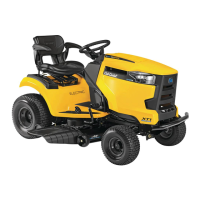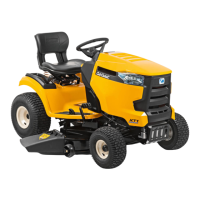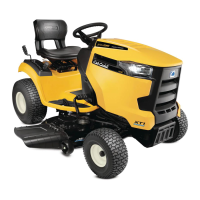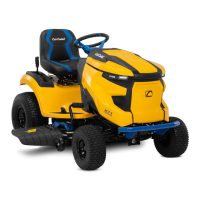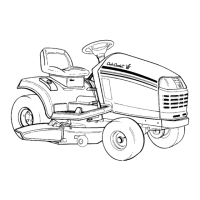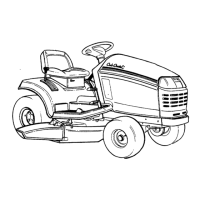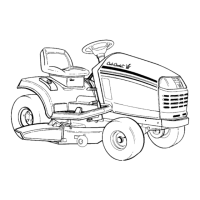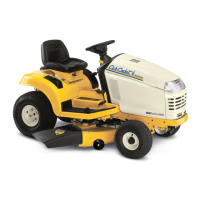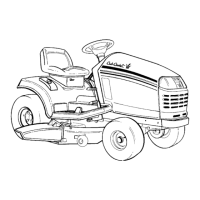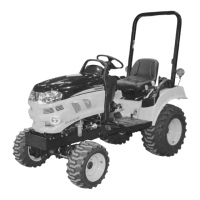16
SERVICE AND MAINTENANCE
NOTE: When replacing the blade, be sure to install the blade with the side of
the blade marked ‘‘Bottom’’ (or with a part number stamped in it) facing the
ground when the tractor is in the operating position.
7. Reinstall blade when properly sharpened. Torque to 450-600 in-lbs (50.9-
67.8 N-m).
Off-Season Storage
Storing the Tractor
• Allow the tractor to cool in an open area before storing.
• Do not park the tractor near any flammable materials (wood, cloth or
chemicals) or any open flames or other potential source of ignition (furnace,
water heater or any other type of heater).
• Remove all combustible materials from the tractor before storing. Empty
cargo boxes, grass catchers or containers.
Removing the Tractor from Storage
1. Fully charge the battery and inflate the tires to the recommended pressures.
2. Drive the tractor without a load to make certain all the tractor systems are
functioning properly.
Battery Storage
1. The battery should be stored with a full charge. A discharged battery can
freeze faster than a charged battery in cold temperatures.
2. The battery charger should remain connected to the charging port on the
tractor when not in use.
3. If keeping the charger connected during off-season storage is not possible,
the battery should be fully charged once every month.
NOTE: It will take approximately 4 hours to fully charge the battery. Leaving
the battery connected to the charger for more than 4 hours will not damage
the battery.
4. Battery should not be kept in a discharged state. Permanent damage to the
battery can occur.
5. Fully recharge the battery before returning to service.
Battery Disposal
Disposing of Damaged or Worn-Out Battery
WARNING
• The following toxic and corrosive material is used in this battery:
LITHIUM-ION, a toxic material.
• Do not use broken or cracked batteries, even if there is no leakage.
Replace damaged or worn-out batteries with new batteries. DO NOT
ATTEMPT TO REPAIR BATTERIES! Repair attempts may result in severe
personal injury, due to explosion or electrical shock.
To avoid personal injury and damage to the environment:
• Do not attempt to remove or destroy any of the battery components. Do not
open or mutilate the battery. If a leak develops, released electrolytes are
corrosive and toxic. Do not get the solution in your eyes or on your skin, and
do not swallow it.
• Do not dispose of the battery in the regular household trash.
• Do not dispose of the battery in a fire. The cell may explode.
• Do not dispose of the battery where it will become part of any waste landfill
or municipal solid waste stream.
• Contact your local authorized service dealer for proper battery recycling.
Deck Installation
To install the deck, reverse the Deck Removal instructions.
Blade(s)
WARNING
• Power off the tractor and remove the key before removing the
cutting blade(s) for sharpening or replacement. Protect your hands
by using heavy gloves when grasping the blade.
• Periodically inspect the blade and/or deck motor casting for cracks
or damage, especially after you have struck a foreign object. Do not
operate the tractor until damaged components are replaced.
CAUTION
If the cutting edge of the blade has previously been sharpened, or if any
metal separation is present, replace the blades with new ones.
Sharpening or Replacing
the Blades
1. Remove the deck from
beneath the tractor, (refer
to Deck Removal earlier in
this section) then gently
flip the deck over to expose
its underside.
2. Place a block of wood
between the deck housing
baffle and the cutting blade to
act as a stabilizer. See
Figure 26.
3. Remove the hex screw (a)
and the blade bell support
(b) which holds the blade
(c) and the blade adapter
(d) to the deck motor. See
Figure 27.
4. Remove blade (c) and
adapter (d) from the deck
motor spindle. See Figure 27.
5. To properly sharpen the
cutting blade, remove equal
amounts of metal from both
ends of the blade along the
cutting edges, parallel to
the trailing edge, at a 25° to
30° angle. Always grind each
cutting blade edge equally
to maintain proper blade
balance. See Figure 28.
6. Test the blade’s balance
using a blade balancer. Grind
metal from the heavy side
until it balances evenly.
WARNING
A poorly balanced blade will cause excessive vibration, may damage the
tractor and/or result in personal injury.
Figure 26
(d)
(c)
(a)
(b)
Figure 27
Figure 28
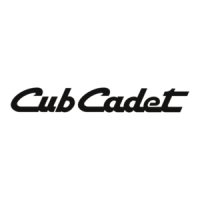
